
Images of a Legend
Ask any eight-year-old
girl in America who Susan B. Anthony was and you'll likely get a blank stare.
But mention Pocahontas and the child's face will light up, no doubt with a
vision of Disney's beautiful "princess" dancing in her mind. Few
figures in American history are as legendary. For 400 years, playwrights and
moviemakers, painters and sculptors, toy manufacturers and tobacco sellers have
portrayed Pocahontas, shaping her appearance and narrative to suit their own
purposes. To explore the wide-ranging representations and compare myth to
verifiable history, the Virginia Historical Society, led by curators William
Rasmussen and Robert Tilton, assembled more than 40 paintings, prints,
drawings, sheet music, and other objects. Below, see a sampling of their
remarkable exhibit. For more background on their endeavor, read the
introduction from Rasmussen and Tilton's exhibit catalog.—Susan K.
Lewis
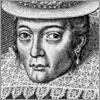

|
|
POCAHONTAS
1616,
Simon van de Passe
This engraving is the
only known portrait of Pocahontas rendered from life. During her stay in
England, Dutch engraver Simon van de Passe captured her likeness and recorded
that she, like the artist himself, was 21 years old. It was the first of many
depictions of Pocahontas intended to demonstrate that a Native American could
adopt the demeanor of a "civilized" European. The Virginia
Company—backers of the Jamestown settlement—likely commissioned the
engraving with this in mind, hoping to attract more colonists and investors.
The image also promotes the false impression that she was a princess in the
European sense; the inscription describes her as the daughter of a mighty
emperor, and the ostrich feather in her hand is a symbol of royalty. But this
engraving offers a sound estimate of Pocahontas's true appearance.
|
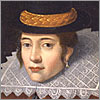

|
|
BOOTON HALL PORTRAIT
likely
1700s, unknown English artist
This widely exhibited oil painting, now part of the National Portrait Gallery's collection, veers from the 1616 de Passe engraving in telling ways. Made long after Pocahontas's death, the painting bears text (out of sight here) that mistakenly calls her the wife of Thomas, rather than John, Rolfe. Subtler, yet perhaps more meaningful, distortions exist as well. Her dark skin and black hair have become white and brown respectively, and her facial features more delicate. She retains the chaste, high-necked Jacobian costume of the engraving (which may have covered the real Pocahontas's tattoos), but her jacket is softer and more feminine. Altogether, she seems closer to an 18th-century European ideal of beauty than a 17th-century Powhatan Indian.
|
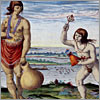

|
|
A CHEIFF LADYE OF
POMEIOOC
1590,
Theodor de Bry (after John White)
If she had never been
abducted and married into English culture, how would Pocahontas have appeared
as a young woman? What did she look like as an adolescent, when John Smith
first encountered her? A hint of the answers may lie in this colored engraving
based on watercolors done by John White, an English artist and explorer who
lived among native Virginians in 1585-86, roughly a decade before Pocahontas's
birth. According to White's images and related text, a Powhatan girl wore no
clothing before puberty. From about the age of 12 onward, she donned a deerskin
skirt, perhaps decorated with beads or carved with figures from nature.
Powhatan women also adorned themselves with tattoos and body paint derived from
roots, as well as necklaces, bracelets, and earrings strung with freshwater
pearls, shell beads, copper, animal teeth, or beads of bone.
|
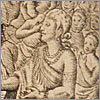

|
|
KING POWHATAN COMANDS
C. SMITH TO BE SLAYNE, HIS DAUGHTER POKAHONTAS BEGGS HIS LIFE …
1624,
Robert Vaughan
While its artistry is
crude at best, this small engraving is a landmark in the Pocahontas legend: the
first visual representation of the famous, and still hotly debated, story of
her "rescue" of John Smith. The engraving was published in Smith's Generall
Historie, where the
self-promoting adventurer recorded the event, 17 years after it supposedly took
place. The artist attempts to be faithful to Smith's account: "Two
great stones were brought before Powhatan: then as many as could layd hands on
him [Smith, here writing about himself in the third person], dragged him to them, and thereon laid his head, and being ready
with their clubs, to beate out his braines, Pocahontas the Kings dearest
daughter, when no intreaty could prevaile, got his head in her armes, and laid
her owne upon his to save him from death: whereat the Emperour was contented he
should live to make him hatchets, and her bells, beads, and copper."
|
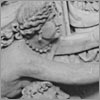

|
|
PRESERVATION OF
CAPTAIN SMITH BY POCAHONTAS
1825,
Antonio Capellano
In
the 200 years following Smith's Generall Historie, other representations of Pocahontas and the
"rescue" were concocted, but it wasn't until the early 19th
century that her status as a mythic figure took flight. This sandstone carving
in the U.S. Capitol Rotunda is a case in point. By 1825, the rescue of Smith
had been popularized in romantic novels, biographical dictionaries, and dramas
such as The Indian Princess.
It had also been placed within the chain of events leading to the founding of
the American republic, so it seemed a fitting subject for the capitol building.
Sculptor Antonio Capellano made his relief simple and bold to ensure the story
was readily identifiable in the sculpture's location high above the
western door of the rotunda.
|
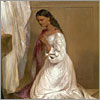

|
|
THE BAPTISM OF
POCAHONTAS
1836-40,
John Gadsby Chapman
Pocahontas stars in an
even more significant piece of art in the U.S. Capitol rotunda: John Gadsby
Chapman's monumental, 12-by-17-foot mural. Chapman received the
prestigious commission in 1836 and researched his subject exhaustively. But the
scant historical record and, more critically, Chapman's cultural
prejudices led to a largely imaginary scene. A Virginian himself, Chapman may
have chosen the subject, in part, to respond to New Englanders of the day who
argued that their "Pilgrim" forefathers established the moral
foundations of the republic. In his painting, Virginia's founders are
given credit for their missionary effort: Pocahontas, sanctified in a white
dress and kneeling like the Virgin Mary, renounces her Powhatan ways. In a
pamphlet on his painting, Chapman noted that Jamestown's colonists did
not "exterminate the ancient proprietors of the soil, and usurp their
possessions." Rather, they spread "the blessings of Christianity
among the heathen savages."
|


|
|
JOHN ROLFE AND
POCAHONTAS
early
1850s, J. W. Glass
A decade after the
unveiling of Chapman's celebrated Baptism, a young portrait painter named James William
Glass hoped to play on Chapman's success with his own, more modest
painting. His Pocahontas and John Rolfe resemble those in Chapman's
mural, and he depicts a foundational event for the baptism—Rolfe's
tutelage of his future wife. But in this painting, as in many other portrayals
of Pocahontas in the 19th century and beyond, she has become the heroine in a
romance; both she and Rolfe appear more interested in each other than in the
crucifix to which he gestures.
|
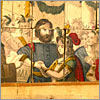

|
|
MARRIAGE OF POCAHONTAS & ROLFE
c. 1868, S. L. Hill (manufacturer)
Many children in the 19th
century, like those of today, learned some version of the Pocahontas legend in
their history lessons. They also saw her depicted in storybooks such as The
Royal Illuminated Book of Legends
(Edinburgh, 1872) and on toys like this jigsaw puzzle made of 20 wooden blocks
with colored paper surfaces. An inscription on the box of the puzzle dates it
to 1868, but the image of Pocahontas's marriage derives from a popular
engraving published in New York, London, and Edinburgh in 1855.
|
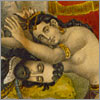

|
|
SMITH RESCUED BY
POCAHONTAS
1870,
Christian Inger (after Edward Corbould)
While some 19th-century images of Pocahontas highlighted her marriage to John Rolfe, countless others focused instead on her feelings toward John Smith. Most historians doubt that a full-fledged romance ever existed between Pocahontas and Smith, but this notion was widely spread in the early 19th century, sparked by writer John Davis, who transformed Pocahontas into the heroine of an elaborate romantic narrative. This 1870 lithograph shows a Pocahontas typical of such representations—Europeanized and overly nubile for an adolescent girl. It also bears inaccuracies common in late 19th-century artwork, when headdresses, horses, and tepees (the latter not seen in this detail), which are trappings of Western Plains cultures, became generic icons for all "Indians."
|
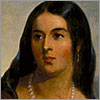

|
|
POCAHONTAS
1852,
Thomas Sully
This regal portrait,
painted by the renowned artist Thomas Sully, seemed a fitting treatment of the
woman who had come to be called the "mother" of the nation by the
1850s. Southerners in particular claimed Pocahontas as a progenitor; indeed,
her descendants through her son Thomas Rolfe were among the most prominent
families in the South. In Sully's portrait, Pocahontas's features are more
Mediterranean than Powhatan, but this image of her became one of the best known
and most copied. It was even adapted for the banner of a Confederate militia
unit that called itself the "Guard of the Daughters of Powhatan."
|
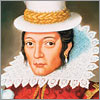

|
|
POCAHONTAS
1994,
Mary Ellen Howe
After
nearly four centuries of mythmaking, could Pocahontas's true appearance be
resurrected? Virginia portrait artist Mary Ellen Howe hoped that it could, and
she spent six years researching and producing what may be the most accurate
portrait of Pocahontas that can be painted. Howe's starting point was de
Passe's 1616 engraving, but unlike the painter of the copy made in the 1700s,
she made certain that the colors of her work were appropriate: Pocahontas's
beaver hat is white, her hair black, and her skin tone modeled after that of
Pamunkey, Mattoponi, and Rappahannock Indians. As she studied the facial
structures of modern Virginia Indians, Howe noticed the same overbite, dimpled
chin, and high cheekbones that van de Passe saw in Pocahontas. Asked why she
devoted herself to this endeavor, Howe explains that she could not forget a
woman whose extraordinary accomplishments included the adoption of a foreign
culture and the winning of acceptance by 17th-century English society.
|


|
|
POCAHONTAS RESCUES
SMITH
1995,
Walt Disney Studios
With Disney's release of
the animated feature Pocahontas,
a new incarnation of her is now familiar to a vast worldwide audience. Some
critics have argued that Disney's "princess" is older than the
Powahatan girl John Smith would have encountered, that the romance between them
is fanciful, and that the depiction of her strays from historical reality in
other ways. If so, it is in keeping with a long tradition. Like other artists,
the writers and animators behind the film integrate elements of fantasy with
historical facts, and they reflect cultural biases of their own time. They both
capitalize on her legend and pay tribute to her as an individual of unusual
energy and vision who influenced the course of history.

|
|


We recommend you visit the interactive version. The text to the left is provided for printing purposes.
|














